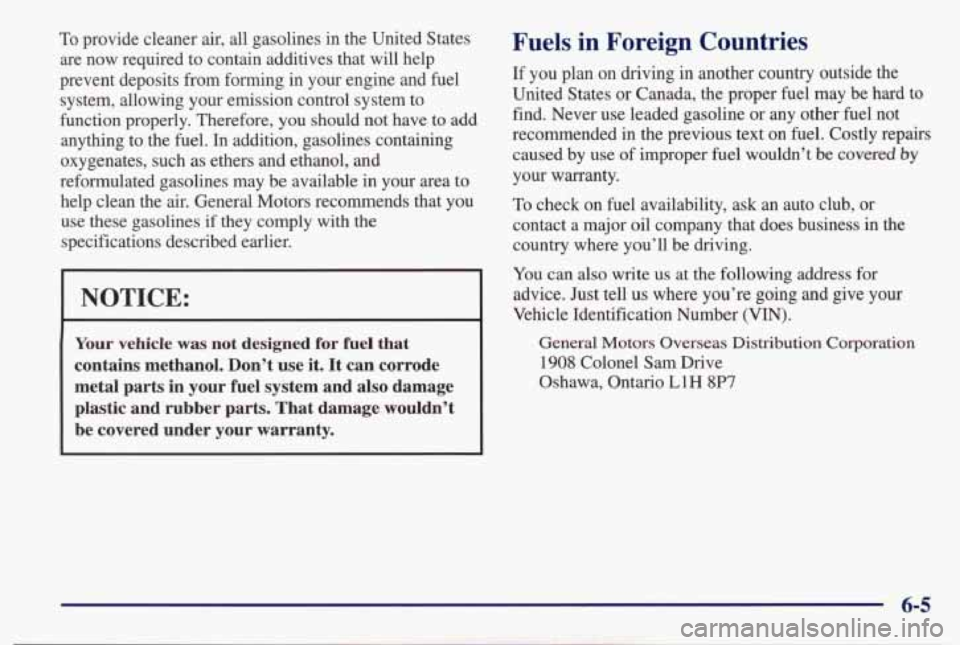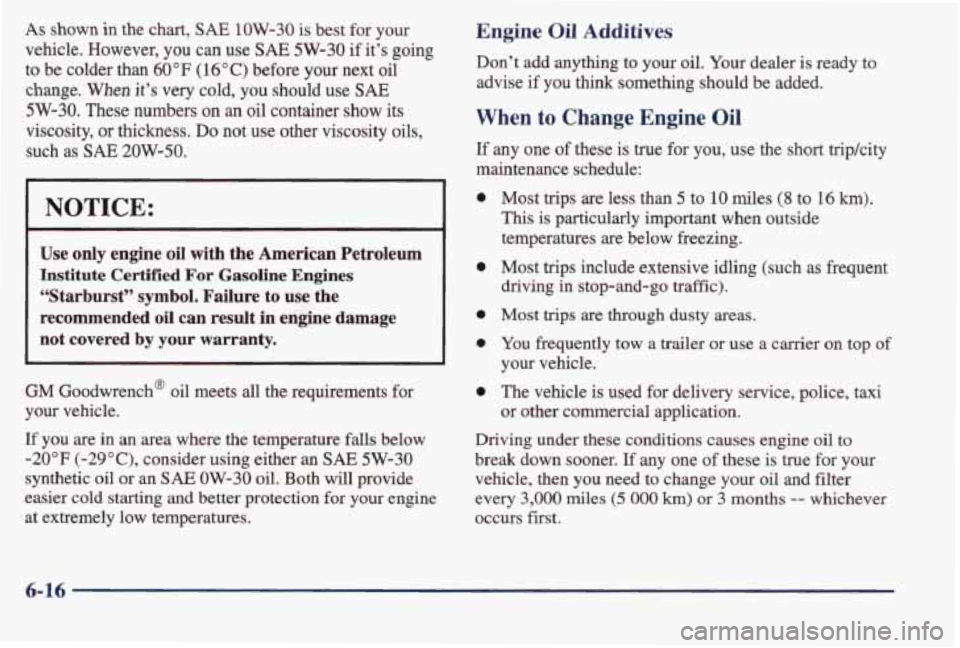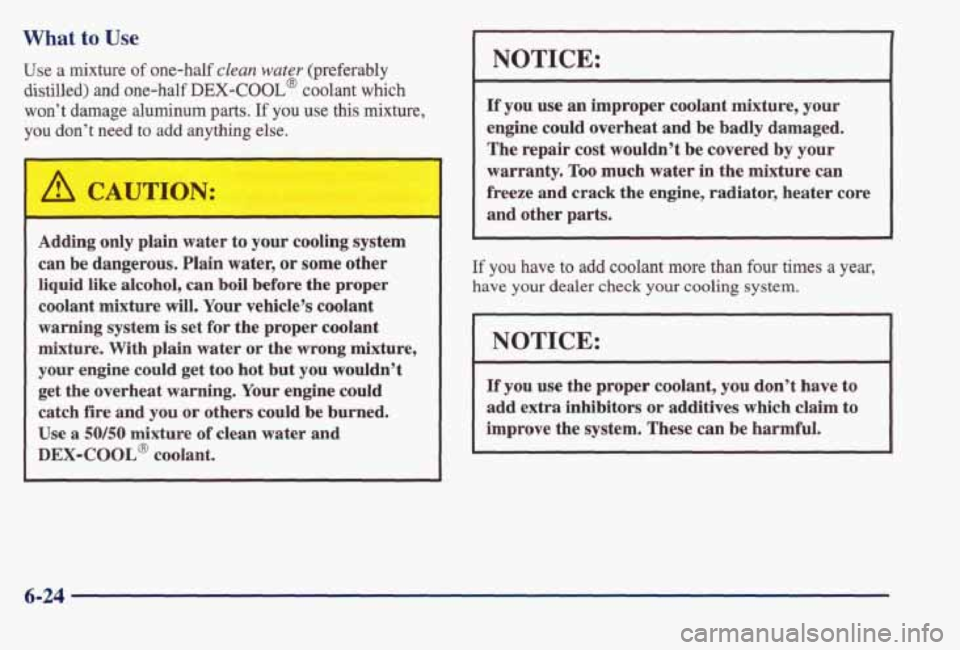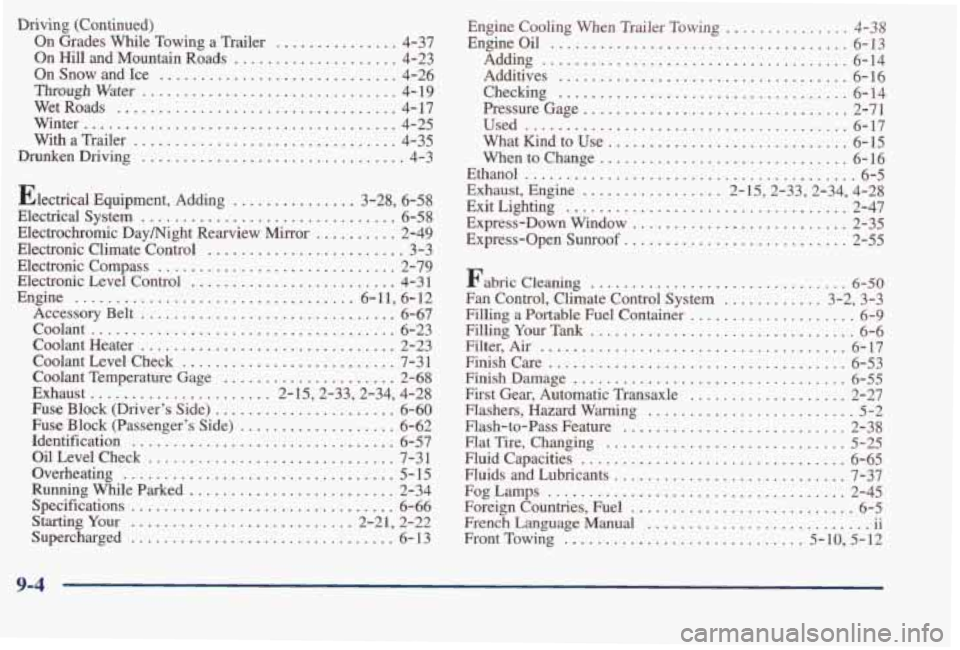1998 PONTIAC BONNEVILLE oil additives
[x] Cancel search: oil additivesPage 256 of 395

To provide cleaner air, all gasolines in the United States
are now required to contain additives that will help
prevent deposits from forming in your engine
and fuel
system, allowing your emission control system to
function properly. Therefore, you should not have to add
anything to the
fuel. In addition, gasolines containing
oxygenates, such
as ethers and ethanol, and
reformulated gasolines may be available in your area to
help clean the
air. General Motors recommends that you
use these gasolines
if they comply with the
specifications described earlier.
NOTICE:
Your vehicle was not designed for he1 that
contains methanol. Don’t use it. It can corrode
metal parts in your fuel system and
also damage
plastic and rubber parts. That damage wouldn’t
be covered under your warranty.
Fuels in Foreign Countries
If you plan on driving in another country outside the
United States or Canada, the proper fuel may be hard to
find. Never use leaded gasoline or any other
fuel not
recommended in the previous text on fuel. Costly repairs caused by use of improper fuel wouldn’t
be covered by
your warranty.
To check on fuel availability, ask an auto club, or
contact a major oil company that does business in the
country where you’ll be driving.
You
can also write us at the following address for
advice. Just tell
us where you’re going and give your
Vehicle Identification Number
(VIN).
General Motors Overseas Distribution Corporation
1908 Colonel Sam Drive
Oshawa, Ontario
L1H 8W
Page 267 of 395

As shown in the chart, SAE 1OW-30 is best for your
vehicle. However,
you can use SAE 5W-30 if it's going
to be colder
than 60 "F (1 6" C) before your next oil
change. When it's very cold, you should use SAE
5W-30. These numbers on an oil container show its
viscosity,
or thickness. Do not use other viscosity oils,
such as
SAE 20W-50.
NOTICE:
Use only engine oil with the American Petroleum
Institute Certified For Gasoline Engines
"Starburst" symbol. Failure to use the
recommended
oil can result in engine damage
not covered by your warranty.
GM Goodwrench@ oil meets all the requirements for
your vehicle.
If you are in an area where the temperature falls below
-20°F (-29"C), consider using either an SAE 5W-30
synthetic oil or an SAE OW-30 oil. Both will provide
easier cold starting
and better protection for your engine
at extremely low temperatures.
Engine Oil Additives
Don't add anything to your oil. Your dealer is ready to
advise if you
think something should be added.
When to Change Engine Oil
If any one of these is true for you, use the short tripkity
maintenance schedule:
0
0
0
0
0
Most tsips are less than 5 to 10 miles (8 to 16 lun).
This is particularly important when outside
temperatures are below freezing.
Most
trips include extensive idling (such as fiequent
driving
in stop-and-go traffic).
Most trips are through dusty areas.
You frequently tow a trailer or use a carrier on top of
your vehicle.
The vehicle
is used for delivery service, police, taxi
or other commercial application.
Driving under these conditions causes engine oil to
break down sooner.
If any one of these is true for your
vehicle,
then you need to change your oil and filter
every
3,000 miles (5 000 km) or 3 months -- whichever
occurs
first.
6-16
Page 275 of 395

What to Use
Use a mixture of one-half clean water (preferably
distilled) and one-half DEX-COOL@ coolant which
won’t
damage aluminum parts. If you use this mixture,
you
don’t need to add anything else.
Adding only plain water to your cooling system
can be dangerous. Plain water, or some other
liquid
like alcohol, can boil before the proper
coolant mixture will. Your vehicle’s coolant
warning system
is set for the proper coolant
mixture. With plain water or the wrong mixture,
your engine could get too hot but you wouldn’t
get the overheat warning. Your engine could
catch fire and
you or others could be burned.
Use
a 50/50 mixture of clean water and
DEX-COOL@ coolant.
NOTICE:
If you use an improper coolant mixture, your
engine could overheat and be badly damaged.
The repair cost wouldn’t be covered by your
warranty. Too much water in the mixture can
freeze and crack the engine, radiator, heater core
and other parts.
If you have to add coolant more than four times a year,
have your dealer check your cooling system.
I NOTICE:
If you use the proper coolant, you don’t have to
add extra inhibitors or additives which claim to
improve the system. These can be harmful.
6-24
Page 377 of 395

Driving (Continued) On Grades While Towing a Trailer
............... 4-37
On Hill and Mountain Roads
.................... 4-23
On Snow and Ice
............................. 4-26
ThrmrghWatm ............................... 4-19
WetRoads
.................................. 4-17
Winter
...................................... 4-25
With a Trailer
................................ 4-35
Drunken Driving
................................ 4-3
Electrical Equipment. Adding
............... 3.28. 6.58
Electrical System
............................... 6-58
Electrochromic Daymight Rearview Mirror
.......... 2-49
Electronic Climate Control
........................ 3-3
Electronic Compass
............................. 2-79
Electronic Level Control
......................... 4-31
Engine .................................. 6.11. 6.12
Accessory Belt
............................... 6-67
Coolant
..................................... 6-23
Coolant Heater
............................... 2-23
Coolant Level Check
.......................... 7-31
Coolant Temperature Gage
..................... 2-68
Exhaust ...................... 2-15.2-33.2-34. 4-28
Fuse Block (Driver’s Side)
...................... 6-60
Fuse Block (Passenger’s Side) ................... 6-62
Oil Level Check .............................. 7-31
Overheating
................................. 5- 15
Running While Parked ......................... 2-34
Specifications
................................ 6-66
StartingYour ...........................2-21. 2-22
Identification
................................ 6-57
Supercharged
................................ 6-13 Engine Cooling When Trailer
Towing ............... 4-38
Engine Oil .................................... 6-13
Adding
..................................... 6-14
Pressure Gage
................................ 2-71
What
Kind to Use ............................. 6-15
When to Change
.............................. 6-16
Ethanol
........................................ 6-5
Exhaust. Engine
................. 2-15.2-33.2-34. 4-28
Express-Down Window
.......................... 2-35
Express-Open
Sunroof ........................... 2-55
Additives
................................... 6-16
Checking ................................... 6-14
Used ....................................... 6-17
ExitLighting
.................................. 2-47
Fabric Cleaning ............................... 6-50
Fan Control. Climate Control System ............ 3-2. 3-3
Filling a Portable Fuel Container
.................... 6-9
FillingYourTank
................................ 6-6
Finishcare
.................................... 6-53
First Gear, Automatic Transaxle
................... 2-27
Flashers.
Hazard Warning ......................... 5-2
Flash-to-Pass Feature ........................... 2-38
Flat Tire. Changing ............................. 5-25
Fluid Capacities
................................ 6-65
Fluids and Lubricants
............................ 7-37
Fog Lamps .................................... 2-45
Foreign Countries, Fuel
........................... 6-5
French Language
Manual ........................... ii
Front Towing
............................. 5-10. 5-12
Filter.
Air ..................................... 6-17
FinishDamage
................................. 6-55
9-4